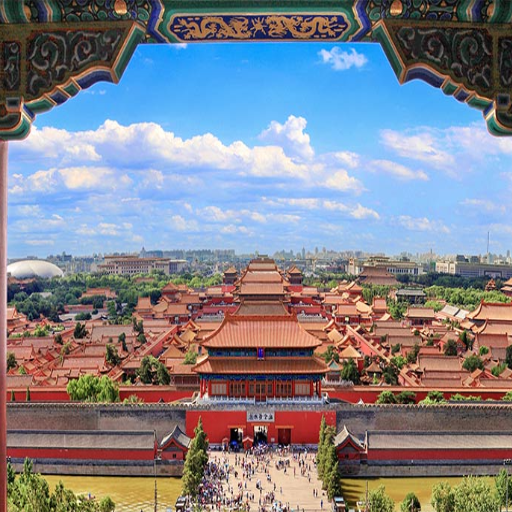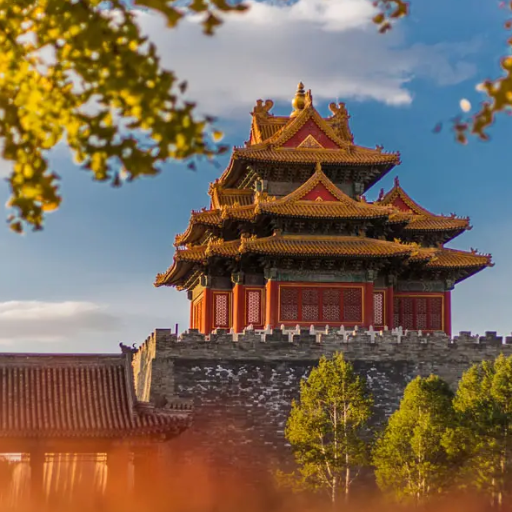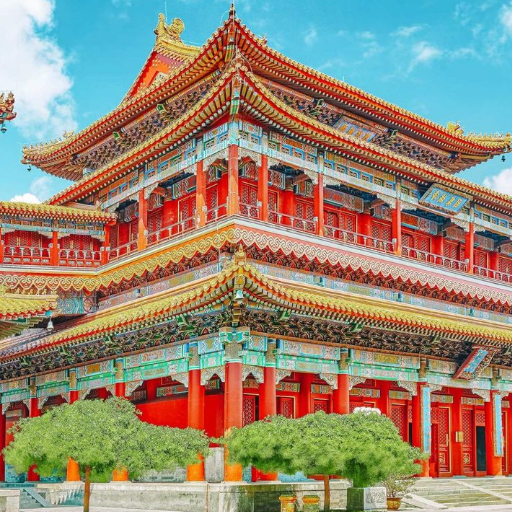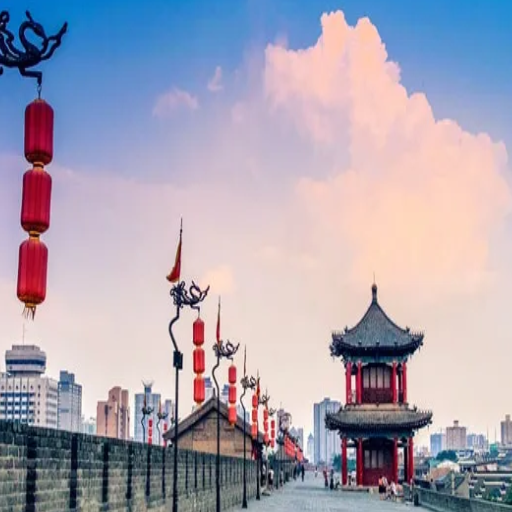The trip from Beijing to Xian offers an unparalleled experience of some of the most well-known landmarks in China. Seamless travel will be your only concern as the guide caters to Xian’s culinary delights and the epic Terracotta Warriors. The wonders of Xi’an and Beijing are ready to be unlocked with the aid of this blog regardless of the imitators fi hteh reed enthuses, culture hniab hsl: hslarknuh traveled, experience much ssmarkceun.
What are the must-see attractions on Beijing to Xian tours?

Exploring the Great Wall and Forbidden City in Beijing
Traveling to Beijing is a fantastic chance to discover the Great Wall of China and the Forbidden City.
The Great Wall is one of the wonders of the world, and its length measures over 13,000 miles. This wall exemplifies excellent structure and ancient history. Badaling is the first section of the wall in Beijing, and it is incredibly famous due to its easy access. On the other hand, Mutianyu is farther away, but the view is worth the drive. Car journeys will take an average of 1-2 hours, and during the summer, traffic won’t be much of an issue in the mornings. Bringing a bigger camera for the panoramic views is strongly recommended.
At the same time, the Forbidden City, located in Beijing, served as the imperial palace in the Ming and Qing Dynasties. This massive 180-acre complex includes 980 preserved buildings showcasing typical Chinese architecture. Visitors need around 2-3 hours to appreciate its highlights, such as the Meridian Gate, the Hall of Supreme Harmony, and the Imperial Garden. Remember that entry is ticket only, and the museum usually operates from 8:30 a.m. to 5 p.m., with seasonal changes.
Combining the two sites provides superb insights into China’s past, which contributes to setting a remarkable Beijing to Xian tour.
Encountering the legendary Terracotta Army in Xi’an
The incorporation of radical ideas in an academic context, the Terracotta Army is one of the finest craftsmen of clay soldiers, which was built by the Qin ruler in 1974 and was revealed to the modern world. The statues depicting animals, chariots, and thousands of soldiers painstakingly sculpted lie in the mausoleum of Qin Shi Huang’s ever-expanding empire. The site exhibits three important pits that host a total of over 7000 lifelike statues, the creation of the tallest and most impressive sculpture in the world, Qin Shi Huang giving him the stance to gaze stoically ahead while mounted on his horse with a bubble of grandeur around him.
Viewing fully all sections of the museum, including an artifact exhibition, a sculpted sitting room for contestants of an ancient battle, and a cinema playing a documentary, will take at least two to three hours. The documentary detailing the first Chinese emperor’s life and era will go for at least 40 minutes while the murmurs of exhausted viewers fill the room. The museum usually opens from 8:30 am to 5:00 pm and extends to peak season overtime. Tickets are obtainable through the web and at the location. Entrance fees are about 120 RMB, and children, the elderly, and students will pay less.
To make your visit worthwhile, guiding services accompanying phone GPS and dubbed sound are deemed useful. During the venture, wear shoes suitable for walking as a lot of distance must be covered on foot. Modern traveling concepts with ancient forms of sculpturing come together and create a picture of a blended past with the present, giving a great experience to everyone who visits.
Walking the Ancient City Wall and Muslim Quarter in Xi’an
Visiting the Ancient City Wall in Xi’an will let you see one of China’s oldest existing combinations of a city’s fortification walls. It is roughly 13.7 kilometers long and goes around the city’s center. Walkers, cyclists, or those in electric carts are treated to stunning views of the older and newer portions of Xi’an. The City Wall was built during the Ming Dynasty and is 12 to 14 meters wide and stands 12 meters tall, fulfilling its defensive purposes, while today, it serves more as a block of space for walking.
Near the City Wall is the colorful Muslim Quarter, which helps people better understand Xi’an’s culture and food history. In this area, local stores stands, and food carts sell homemade lamb kebabs, biang biang noodles, and persimmon cakes. Historically, The Quarter is a significant, energetic, and eloquent place where tourists can engage with the culture.
Critical Notes Access to the City Wall: Gates are available on the wall in significant areas like the South Gate (Yongming Gate), the most visited area.
Hours of Operation: Like many other places, it is usually open as long as daylight is available; however, this may occasionally differ, so double-check.
Bike Rentals: Single and tandem bikes may be rented along the city walls for around CNY 45 an hour.
Muslim Quarter Location: This quarter and its mosque are near the Drum Tower and easily accessible from the city wall.
Walking the Ancient City Wall and visiting the Muslim Quarter together guarantees an in-depth and lively experience of Xi’an’s historical splendor and local culture.
What are the best Beijing and Xian tour packages for 2025?

Private tour options with guide and driver
The all-inclusive private tours with professionally trained guides and drivers for experiencing personalized sightseeing in Beijing and Xi’an are set for 2025. These tours usually contain the features outlined below:
Duration: Flexible from 4 to 8 days based on the choices and plans of the customer.
Destinations Covered: Sights in Beijing, which includes the Great Wall and Forbidden City, the Temple of Heaven alongside the Xi’an, the Terracotta Warriors, the Ancient City Wall, and Big Wild Goose Pagoda.
Transportation: Travel in private, air-conditioned vehicles with assigned drivers, providing comfort and luxury. Regular transfers from Beijing to Xi’an are available by high-speed train or domestic flights.
Expert Guides: Insightful narration is provided by licensed guides who speak English, ensuring appropriate assimilation of the culture and history.
Accommodations: Well-positioned 3-star-5-star hotels within the budget range, providing easy access to famous sites for sightseeing.
Meals: Features lunch in top-rated, local Chinese restaurants offering traditional dishes. Dietary needs tend to be looked after.
Customized Itineraries: Tours can be altered according to travelers’ requirements to capture key areas or spend additional time on important site-seeing options.
The main aim of these packages is to promote sightseeing and help visitors understand the history and culture of Beijing and Xi’an.
Group tour experiences and itineraries
Our group tours strike a careful balance of sightseeing, cultural activities, and relaxation. Below, you’re going to find responses to questions most frequently asked about the services offered, as well as their technical details:
Group Size: To facilitate a personal touch from the guides and easy access to the attractions, the tours are designed for 10-15 participants.
Transportation: Air-conditioned buses or minibusses are used for city tours and inter-city transfers. These vehicles fulfill safety and comfort requirements, including ergonomic seats and climate control.
Tour Duration: Single-day tours last approximately 8 hours, including meal breaks and site visits, while multi-day tours usually take 3 – 5 days, depending on the itinerary. However, some may feel that eight hours is too short.
Key Stops: In Beijing, the stops include the Forbidden City, Summer Palace, and Great Wall. In Xi’an, the stops include the Terracotta Warriors, the Ancient City Wall, and the Muslim Quarter. Each stop has sufficient time so the participants can explore the sites (usually 1-2 for each site).
Guides: We provide professional, bilingual guides with vast experience who accompany the group with historians and ethnographers.
Every tour element is based on customer feedback and operational criteria to achieve an optimal balance between thorough and pleasant exploration of Beijing and Xi’an.
How many days do you need for a Beijing to Xian tour?

1-day Terracotta Warriors tour from Beijing
A one-day tour of the Terracotta Warriors from Beijing is an efficient and unforgettable experience, appropriately crafted for travelers with restrictive timings. Here’s what you need to understand:
Travel Mode: To explore the Terracotta Warriors and Horses Museum site in Beijing and Xi’an, both have round-trip flights to Xi’an, allowing maximum site viewing.
Duration: Details on the trip are flexible, but the total duration, including the flights and exploring time, is approximately 14-16 hours.
Sites Covered: The less famous Xian City Wall or the Muslim Quarter of Xi’an can be visited with enough time, alongside the Chinese lunch and the Terracotta Warriors Museum.
Transportation: The participants will use nonsmoking, well-maintained, modern vans for the entire visit to Xi’an, providing comfort and ease.
Meals: The lunch offered is a traditional Chinese dish that can be modified if required.
Guide services: Professional English guides will assist visitors to the museum and monument, providing in-depth information on the historical features.
This package suits anyone willing to explore China’s famous heritage sites in one day.
3-5 day comprehensive Beijing and Xi’an itineraries
Travelers who wish to appreciate the cultural and historical beauty of Beijing and Xi’an can use the 3-5 day itinerary options provided, which are aimed to be thorough while also ensuring balance for the traveler:
Days 1 – 2 Beijing Highlights:
Key sites – Forbidden City, Tiananmen Square, Temple of Heaven, Summer Palace.
Duration and Activities: Fully dedicated days to World Heritage sites covering the history of the Ming and Qing Dynasties. These sites provide great detail on the UNESCO World Heritage history.
Transportation: Convenience is provided through private transfers between sites and hotel accommodations in Beijing—evening high-speed train tickets to Xi’an on Day 2.
Meals: Local Beijing dishes include Peking duck and other specialties.
Days 3 – 4 Xi’an Attractions:
Key Sites – Xi’an Terracotta Army Museum, Big Wild Goose Pagoda, Huaqing Palace while optionally including Xi’an City wall and Muslim Quarter.
Duration and Activities: These beautiful landmarks are Xi’ans ancient modern days, and guided tours highlight their full cultural importance.
Transportation: Ease of travel to sights enabled by local private vehicles in Xi’an.
Optional Day 5:
Spend the day traveling back to Beijing by high-speed rail or visit prominent Xi’an sites.
Arrange for Tang Dynasty shows and local craft workshops, among other things.
The sightseeing activities are blended with cultural experiences, making this trip between Beijing and Xi’an worthwhile for travelers looking to cover substantial ground in a relaxed and in-depth manner. This progressive immersion is optimized for those looking to accomplish it in 3 to 5 days.
Extended tours, including Beijing, Xi’an, and Shanghai
Travelers who want a more in-depth experience are welcome to travel to Shanghai to gain insight into China’s advanced and historical wonders. In the text below, there are tips about the minimum needed answers and the most essential features regarding the extension planning tour:
Tour Proposal
Days 1-5: Follow the recommended itinerary for Beijing and Xi’an as detailed above.
Day 6: Travel to Shanghai by high-speed train or domestic flight. Travel by rail takes approximately 5 to 6 hours, and by air, it takes 2 to 3 hours, including airport formalities.
Day 7-8: In-depth excursions in Shanghai include The Bund, Yu Garden, Shanghai Museum, Huangpu River, Zhujiajiao water town, and the Pudong skyline. Huangpu River Cruises and visits to water towns are optional activities.
Transport Means
High-speed rail is cost-effective and picturesque. Traveling takes approximately 5 to 6 hours, and it is recommended for less demanding and cost-sensitive tourists.
Domestic Flights: Quicker but more costly. Fit for time-sensitive individuals.
Accommodation Proposals
Beijing & Xi’an: Accessible luxurious 4 or 5-star hotels in central areas allowing easy access to the fundamental tourist sights.
Shanghai: Newer 5-star hotels in the Bund and Pudong areas offer comfort and beautiful skyline views.
Further Details
The Budget: Including Shanghai generally adds approximately $500-$800 to the total price, which includes travel, lodging, and other activities.
Timespan: Most utilize 8-10 days to engage in all three cities.
Weather Considerations: March to May and September to November generally have favorable weather for these locations.
This tour integrates ancient historic landmarks, traditional cultural sites, and modern architectural wonders, making it suitable for travelers who appreciate a diverse itinerary.
What to know before booking Beijing Xian tours

Best times to visit Beijing and Xi’an
Beijing and Xi’an are best visited in springtime (March to May) and autumn (September to November) when pleasant weather is favorable for historical and cultural exploration. In these seasons, temperatures generally fluctuate between 10 and 24 degrees Celsius, ideal for outdoor activities. Moreover, these times of the year are less likely to be affected by severe weather conditions like snowstorms during winter or heatwaves during summer.
Temperature Range: 10 to 24 degrees Celsius — ideal for outdoor exploration.
Rainfall Levels: Moderate during these seasons, guaranteeing little hindrance to travel plans.
Air Quality Index (AQI): Better than winter in Spring and Autumn, especially in Beijing, enhancing overall comfort.
In summary, these good conditions make spring and autumn the best months to appreciate Beijing and Xi’an’s history and cultural richness.
Tour guide options and language considerations
While picking a tour guide, check the options available in your preferred language and select a regional language you are familiar with. For enhanced communication and better service, I suggest utilizing guides who can speak your first language. For instance, if English guides are needed, many well-known agencies in Beijing and Xi’an offer this service. These guides usually have a high level of knowledge about various aspects of history and culture, so they seldom provide scant information during your tour.
Regarding translation, the languages used will not influence technical aspects such as temperature extremes, precipitation amount, rain, or pollen count. On the contrary, a well-spoken and good-mannered professional might plan activities for specific times of day when the weather or air pollution is at its best, thus enhancing their client’s experience. These are the times that people can maximize the spring and autumn months because they are the most pleasing to the eye.
Typical costs for Beijing to Xi’an tours in 2025
To address the issues briefly, I suggest getting an English-speaking guide if fluency is essential. This will help enhance understanding of cultural and historical sites. However, language barriers do not impact the technical aspects of weather, like temperature range, rainfall, and AQI; an astute guide can offer sound strategic advice to improve the experience. For example, outdoor activities can be planned based on accurate forecasts and current air quality.
Best seasons for traveling: Spring and Autumn are the best periods to tour because their temperatures are moderate and there is less rainfall.
Air Quality Index (AQI) information: A competent guide can help avoid places with poor air quality on certain days.
Weather considerations: Guides can advise on clothing or the amount of change to the plan based on daily temperatures or rainfall.
These considerations point to the range of value a knowledgeable guide who can respond to situation dictates offers.
How to plan the perfect Beijing and Xian itinerary

Essential historical sites of ancient China
My visits to China always revolve around their culture because I enjoy engaging in activities that require appreciating rich history. While in Beijing, I visited the Temple of Heaven and the Forbidden City, which offer unrivaled architecture. The Great Wall of China does not fall short of providing stunning views and is another important landmark. While in Xian, I made sure that I would visit the ancient City Wall and Terracotta, which are some of the main pillars of the region’s rich history.
Best seasons to travel: I recommend visiting during spring or autumn to ensure pleasant weather when strolling around the City wall and the Forbidden City.
Air Quality Index: Attention to air quality is crucial, especially if you plan to visit the Great Wall or City Wall during your time in Xian.
Weather considerations: Light, breathable clothes are essential for warm days, and layering attire for cooler spring evenings is a good call.
Balancing temple visits, cultural experiences, and modern attractions
To visit the temples while appreciating the culture and modern attractions, a well-laid-out plan is needed to make the most out of each endeavor. From personal experience, I prefer doing temple visits first thing in the morning as the weather is cooler and with fewer crowds, making the spiritual visits more fruitful. When I think of cultural experiences like traditional performances and museums, I try to schedule them around noon when the temperatures and AQI make the outdoors less desirable. In the evening, after a long day, I find it easier to visit modern attractions as they add a vibrant touch to the day.
Strategy for visitation: Temples should be used in the morning since they are calmer and quieter, indoor activities like museums around noon, and modern attractions in the evening.
Air Quality Index (AQI): Planning indoor activities when the outdoor AQI is less favorable, like midday for some urban centers.
Weather considerations: Planning to wear multiple layers to adjust to increasing or decreasing temperature changes throughout the day.
With this balanced approach to planning my itinerary, I can rest assured that I am enjoying my time while meeting the technical, environmental, and timing standards.
Day trip options from Beijing and Xi’an
In my strategy for day trips from Beijing, my travel radius is confined to 2-3 hours of train or car ride to maximize exploration. The Great Wall is an exceptional piece of engineering, especially the Mutianyu section. It is more worthy than Badaling because it is dreamy and historical and less inflicted by tourist crowds. My ideal tea plant visit time is midmorning since it is less popular among the hordes of tourists. This way, I can enjoy cooler temperatures that complement the optimal visit times noted above. In addition, layer dressing is beneficial for unexpected temperature changes, which meet the Weather considerations above.
In Xian, the Terracotta Army was a must-visit. It is recommended for a half-day trip. The only downside is that it is roughly located an hour outside the city. To minimize the crowds, I try to plan my visit for the morning alongside better conditions in the region when considered through the Air Quality Index (AQI) strategy. I include break hours with low time restrictions on meals and small exhibits for both destinations to comply with AQI and weather considerations. Following this form of planning ensures that the critical elements of time, air quality, and weather are rationalized and considered while still resulting in an enjoyable and efficient trip.
Frequently Asked Questions (FAQs)
What are the key features of the China tour, which starts in Beijing and ends in Xian?
A: Along with Xian, the tour, which starts from Beijing, will also include famous sites like The Great Wall of China (especially the Mutianyu Great Wall section), The Temple of Heaven, The Summer Palace, and Tiananmen Square. In Xian, you will see the incredible Terracotta Warriors and Horses Museum, Ancient City Wall, Wild Goose Pagoda, and the Muslim Quarter. The tours provide an opportunity to see some of China’s most important cities and understand the country’s imperial history, dating back to the Ming dynasty and beyond.
Q: What do I need to understand in advance before purchasing the Beijing Xian tours?
A: Always keep in mind the time required to travel from one city to the other (approximately 5-6 hours on a high-speed train or 2 hours by airplane), what seems to be the best and most realistic time frame (ideally 5-7 days for the cities combined), if you would prefer a day tour or an overnight bus trip to Xian. Springtime (April-May) and fall (September-October) are the best times to travel. Set a budget because the tours range from essential to plush spending, and think about whether you’ll need a travel consultant to assist with planning international flights and bookings.
Q: Is visiting Xian from Beijing by plane or train more effective?
A: Each option provides its benefits. The bullet train is slightly more reliable and takes around five to six hours, but you can enjoy beautiful views during the trip. Flights from Beijing Daxing International Airport are quicker, taking around two hours. However, they do suffer from possible weather delays. Train travel is a superb option for tourists wishing to experience China’s advanced rail system, while those with time restraints prefer flights.
Q: Can I travel from Beijing to Xian in a single day?
A: A day trip to Xian is possible but not ideal due to time constraints. You leave Beijing on the earliest flight and return using the latest option. This leaves you with eight hours in Xian to enjoy the Terracotta Warriors Museum and another attraction. For a worthwhile trip, staying overnight between two to three days would be best.
Q: What is the best way to view the Terracotta horse riders and the other Xian highlights?
A: To understand the essence of the Terracotta Warriors and Horses, it is advisable to have a guided tour at your disposal. A consolidated day tour with Beijing-Xian should offer pickup services from the Terracotta Warriors Museum, an hour’s drive from the Xian City, The Ancient City Wall,/Drum Tower, or Wild Goose Pagoda. To further appreciate and grasp the essence of these monumental sites, consider taking a private guide who is well-versed in Chinese history.
Q: Is there a route that connects Beijing to Xian using a high-speed train?
A: To travel on a high-speed bullet train, one must leave from the Beijing West Railway Station, and your destination will be the Xian North Train Station. Trains are offered throughout the day, every half hour to hour, with a total ride length of around 5 to 6 hours. It is wise to purchase tickets beforehand, especially if you are traveling during peak seasons. First- and second-class seats can be selected, with much cheaper first-class seats. After disembarking at Xian train station, people and cars will be at your service to drive you to your residence.
Q: How long is it recommended to spend on travel from Beijing to Xian?
A: The optimum time frame for an all-encompassing tour from Beijing to Xian is 6-8 days. This provides enough time to spend 3-4 days in Beijing to visit the Mutianyu Great Wall, Summer Palace, Temple of Heaven, and Tiananmen Square. You can allocate around 2-3 days for the Terracotta Warriors, Ancient City Wall, and other sights for Xian. This duration is achievable at a leisurely pace. It allows sufficient time to understand both cities’ Chinese history and culture and commute between them, unlike travel, which is much tighter.
Q: Do you have any overnight train options for tours between Beijing and Xian?
A: Overnight trains and high-speed train options are available, along with other economic choices that can reduce accommodation expenses. Overall, the train takes roughly 11-12 hours, where the traveler gets on in the evening and arrives in Xian during the morning. There are various accommodation options, with a hard seat and hard sleeper (6 berths per compartment) and a soft sleeper (4 berths per compartment). This type of train is not as favorable as the bullet train in speed and comfort, but the unique cultural experience more than makes for it.